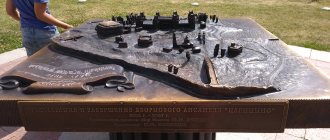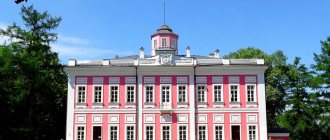The permafrost of Eastern Siberia is a giant climate time bomb - hidden beneath it are huge reserves of carbon dioxide and methane, which will be released into the atmosphere as they melt. So, at least, say Russian scientists Sergei and Nikita Zimov. They believe that restoring the ecosystem that existed here thousands of years ago will help stop warming. Therefore, for several years now the Zimovs have been developing the Pleistocene Park: a small area that is inhabited by large mammals that survived the Ice Age. Using crowdfunding platforms, by the spring of 2021 they had already raised about $118 thousand to deliver bison from Alaska to Yakutia. And for several years now they have been seriously talking about the return of mammoths.
What is known about the project of Russian scientists is in the material of the portal iz.ru.
Museum halls
The main available exhibitions are located in the Ice Age museum-theater. The first hall displays exhibits related to extinct ancient animals that lived together with mammoths. Here you can see skulls, horns, skeletons and even mummified remains of skin:
- primitive bison;
- cave bears;
- woolly rhinoceroses;
- cave lion;
- fossil wolf.
Group of mammoths, © iceagemuseum.ru
In the central hall there is a group of life-size mammoths. The composition is installed on a rotating podium equipped with original lighting. The exhibition includes everything related to the main symbol of the Ice Age - the mammoth. Skulls, jaws, fur, teeth, tusks, mummified skin and other evidence of the existence of giant animals found on numerous expeditions are exhibited here. The impression of acquaintance with the distant past is enhanced by light and sound special effects.
Another room displays magnificent products by masters of bone carving art:
- decorative interior elements;
- items related to church topics;
- animal figurines;
- decorations;
- figurines;
- caskets;
- vases;
- knives, etc.
The products are made from mammoth tusks - an excellent ornamental material. In addition, the collection contains engraved walrus tusks, collectible tusks and sperm whale teeth. Unique works by masters of the best bone-carving schools, which are items of luxury and exquisite interior design, can not only be seen, but also bought or ordered.
Bone carving product made from mammoth ivory, © nlr0104
The separate room “Berengia” presents an amazing collection of stuffed animals, made at a highly artistic level. Panoramic views of the blooming tundra are visualized here, bringing visitors to real delight, and photographs of places where extinct animals once lived are posted.
Harvard Mammoths
Now the idea of reviving mammoths no longer seems crazy. Theoretically, the DNA of these animals can be restored using the remains that are regularly found in Yakutia, and then implanted into the closest living relative of the mammoth, the Asian elephant - their DNA still has a lot in common, and the “elephant” elements can be replaced step by step with “mammoth” ones "
One of the main ideologists of the return of mammoths was Harvard scientist George Church. Under his leadership, an international group of scientists created the Revive & Restore project in the early 2010s. The project participants are familiar with the work of Sergei Zimov, have been to Yakutia and really consider it as a potential place of residence for the new generation of mammoths they created. Now the Harvard-based team is working on genome editing, gradually implanting mammoth DNA into elephant cells - work they began in 2014 and have since been able to edit more than 40 elephant genes. It is difficult to predict how much more changes will need to be made.
George Church
Scientist George Church
Photo: wikipedia.org/Steve Jurvetson
However, after this the most difficult part begins, Church admitted to Atlas journalists. Asian elephants themselves are endangered - it is unlikely that anyone will allow scientists to interfere with their reproduction process so that a real elephant can carry a future mammoth. Instead, the embryo will need to be raised in artificial conditions - so far no one has conducted such experiments with large mammals.
It will be hot
Scientists have named countries that will disappear by 2050 and told how to mitigate the effects of global warming
But the frost resistance gene could theoretically help save elephants as a species - animals suffering due to the reduction of their habitats could be resettled in sparsely populated areas of Siberia. Nikita Zimov says that he personally is quite happy with the “big hairy elephant”, and the park is ready to welcome the first giant in at least a week.
Excursions
It will be interesting for both schoolchildren and adults to walk through the halls of the museum-theater. The guides allow you to touch the exhibits - touch the tusks and huge teeth of a mammoth, stroke a woolly rhinoceros and a cave bear, and visit primitive people.
Rock-toothed tiger, © Maria ♥Just Mary♥
The museum staff introduces visitors to the fascinating world of flora and fauna of the northern regions of the planet. They talk about the mammoth period and the reasons for the disappearance of ancient animals, as well as about representatives of the Ice Age who managed to adapt to harsh living conditions and continued to exist until the present day.
During the excursions, interesting topics and little-known facts of a whole layer of history that preceded the glaciation of the earth's cover are touched upon. Museum employees talk about the forms of existence and varieties of extinct animals, as well as the life of cavemen.
The guides will tell you not only about the characteristics of the animals, but also about the curious features and habits of this or that animal, and about interesting cases related to the finds of ancient bones.
Interactive excursions for schoolchildren
Excursions are available upon reservation and only in groups.
The application process is very simple. To make a reservation, you must contact the person responsible for the excursions by phone to clarify:
- date and time of visit;
- number of people (at least 10);
- contacts for feedback.
You should arrive 10-15 minutes before the start of the event. If it is impossible to visit the museum at a pre-agreed time, employees should be notified at least 24 hours in advance by calling the phone number indicated above. In this case, the visit can be rescheduled to another day.
The Ice Age Museum accepts orders for children's parties - bright and memorable. Those present will experience communication with a group of cavemen and an amazing journey into the world of unprecedented animals.
Exhibition of bone carvings, © iceagemuseum.ru
Bison Charter
Officially, the park has been operating there since 1996; the first experiments began even earlier. Now it is considered the main project of the North-Eastern station, but scientists say that they are developing it only with their own personal funds.
During this time, the Zimovs managed to bring about 70 animals here - including musk oxen, bison, reindeer and wild Yakut horses. Hunters from a nearby half-abandoned shift town do not touch them due to “personal connections,” Nikita Zimov proudly explains to reporters. He is the main English-speaking speaker of the park - Sergei does not speak English very well, and in general prefers questions of a scientific and philosophical nature to business negotiations.
deer
Reindeer
Photo: Pleistocene Park/facebook.com
Last spring, they began collecting money to bring a herd of bison from Alaska to Yakutia - in the Pleistocene era, bison were one of the main inhabitants of the local steppes. In Russia, suitable young animals were simply not found in the required quantities.
According to the laws of the tundra
Why did deer begin to die en masse in Yamal?
“At first I wanted to buy an old, very old ship and sail through the Bering Strait on it. But we quickly realized that the idea was too crazy even for us. Therefore, we decided to focus on air charter rental,” Nikita Zimov told a New Atlas correspondent in April 2021.
Last year, scientists launched a campaign to raise funds to charter a charter flight on the crowdfunding platform Kickstarter. The amount needed is $106 thousand, but by the spring of 2018, $110 thousand had already been collected. Another campaign started on the Indiegogo website this year: about $18 thousand have been raised there so far.
On April 25, an update appeared on the Kickstarter campaign page - a video of a new batch of yaks arriving at the park. In the near future, the creators also promise to post a video of the flight of Alaskan bison. However, the most prominent participants in that ecosystem remain the extinct mammoths. The Zimovs are confident that the first of them can reach Yakutia in just a few years.
Ancient remains of a mammoth were found by divers in the Kurgan region
Ticket price
The cost of visiting the museum as a group must be clarified by phone when filling out the application. There are no benefits except for free entry for one adult accompanying more than 10 children. Prepayment is required at least one week before the excursion to confirm your reservation. The remaining amount is paid directly at the museum cash desk.
Single visit ticket prices are the same for children and adults. The discount is provided to pensioners upon presentation of the appropriate ID.
- Adults - 350 rubles
- Children (5-13 years old) - 350 rubles
- Pensioners - 200 rubles
Children under 4 years old are admitted free on any day. It is worth remembering that the ticket is only valid on the day of purchase.
You can purchase tickets directly at the exhibition or at the Oceanarium ticket office.
Work in the exhibition hall on Kibalchicha Street has been temporarily suspended. You can track the latest information about the opening of the exhibition in the old building on the official website.
Visiting time
Ice Age Museum in Moscow at st. International, 10 is open daily from 10:00 to 22:00. The room is located in the Oceanarium building on the third floor.
Cave wolf, © nlr0104
History of the Ice Age Museum
The idea of creating a private paleontological center belongs to F.K. Shidlovsky, the owner of most of the museum exhibits. The first object - a mammoth bone - was discovered by him about 40 years ago completely by accident. This happened in the Yakut tundra, where a recent student ended up by chance. The find aroused interest and prompted the young specialist to further search for the remains of extinct animals. The future entrepreneur turned out to be persistent and did not give up even in difficult situations. On the contrary, he developed an excitement that pushed him to organize new expeditions.
For the first time, Shidlovsky managed to find a complete mammoth skeleton 19 years after a chance encounter with the bone of an ancient animal.
Skull of an Ice Age animal, © iceagemuseum.ru
In the 90s of the last century, the paleontologist created a company with a name consonant with his passion - “Mammoth”. Later it became the Shidlovsky National Alliance, and the hobby grew into a business. The found tusks were sold profitably, and valuable finds became exhibits of a unique collection.
In 2004, VDNKh managed to rent pavilion number 71 and exhibit some of the collected paleontological objects there. The museum was called “Ice Age” and quickly gained popularity. However, a significant part of the rent had to be covered from business income. In order to reduce the financial burden on the scientific and exhibition center, which is simultaneously engaged in research work in the field of paleontology, it was decided to change the location of the complex. Today the Ice Age Museum is located at st. Kibalchicha, 6 - on the third floor of the main building of the Institute of Biology and Chemistry of Moscow State Pedagogical University.
In 2021, a new exhibition “Mammoths and Their Surroundings” opened in the Oceanarium building (10 Mezhdunarodnaya St.) on the third floor. The exhibition boasts the most diverse and unusual exhibits of fauna. The hall features: a woolly mammoth, a frozen mummy of an Anyui bison, a mummified fragment of a Bilibino horse and much more.
The first hall of the museum, © iceagemuseum.ru
At the end of the world
To get to the airport closest to the Pleistocene Park, which served as a launching pad for polar expeditions in Soviet times, you need to fly from Yakutsk for about another four hours. According to the park's website, it now occupies about 16 square meters. km in the lower reaches of the Kolyma River. Wild horses, musk oxen, bison, moose and reindeer live here - descendants of mammals that inhabited the so-called mammoth steppes thousands of years ago. Both the animals, unusual for this strip, and the steppes cleared among the tundra are the work of human hands.
horses
Wild horses
Photo: Pleistocene Park/facebook.com
Next to the park stands what, from photographs, would be best described as a number of village houses and barracks huddled around a giant television antenna dish. In fact, this is the Northeast Station, the second largest and most important Arctic research station in the world.
Authorities are preparing documents to create a mammoth center in Yakutia
Its current director, ecologist Sergei Zimov, arrived at the station in the late 1980s. He also moved his family to the kingdom of permafrost, and a few years later he set out to return a small patch of Yakut land to more than 10 thousand years ago.
Today, this 63-year-old man, thin, with a long beard and a tail of gray hair, in a black beret and eternal work overalls, seems to be the embodiment of a mad genius from science, whose ideas can save the planet, or bring the world to the brink of disaster. At least, this is how Zimov appears in reports from foreign publications. Correspondents from The Atlantic, The Daily Telegraph and New Atlas spoke with Sergei and his son, Nikita, and the German TV channel ARD made a documentary about him
However, Zimov, apparently, is known and recognized in scientific circles, including international ones - he was published in the journals Science and Nature, the scientist’s project was presented at the investment forum in Sochi in 2021.











